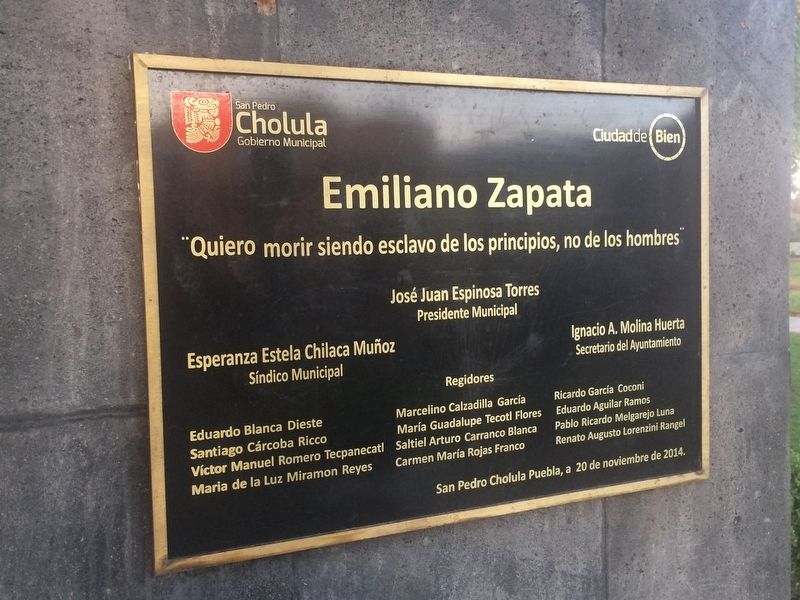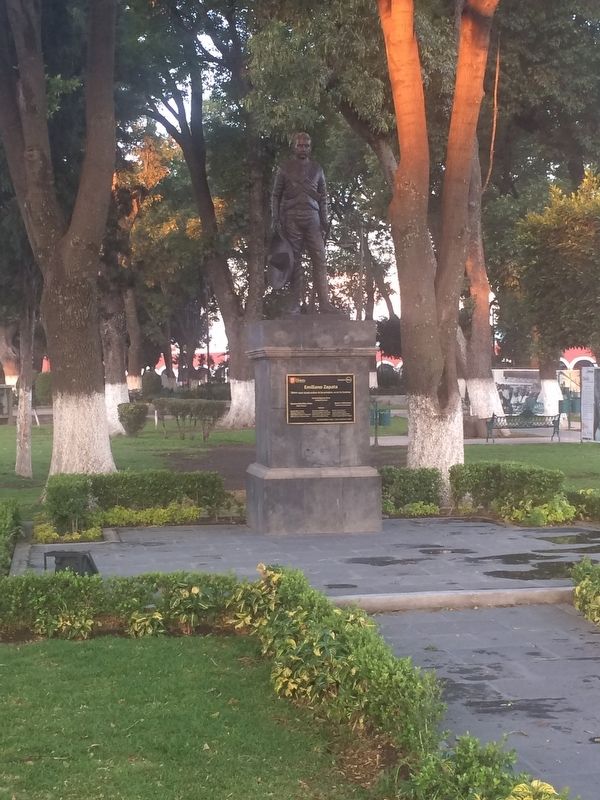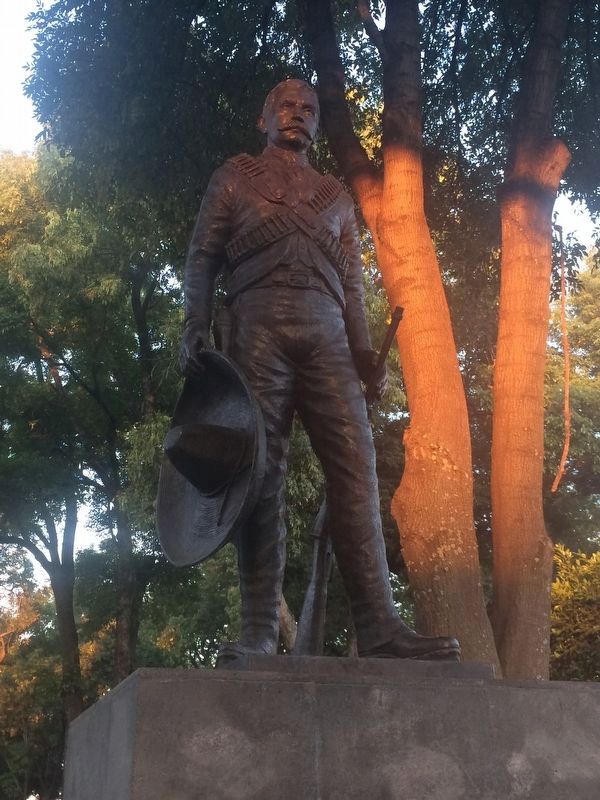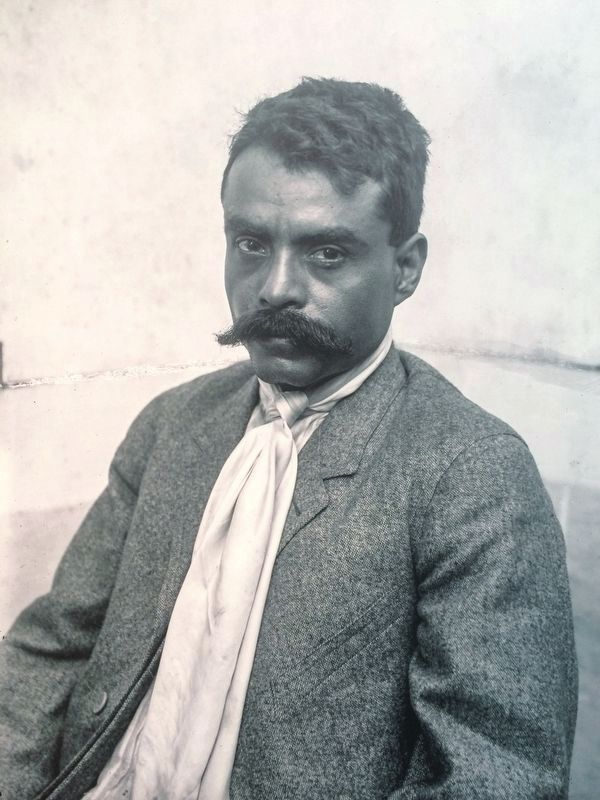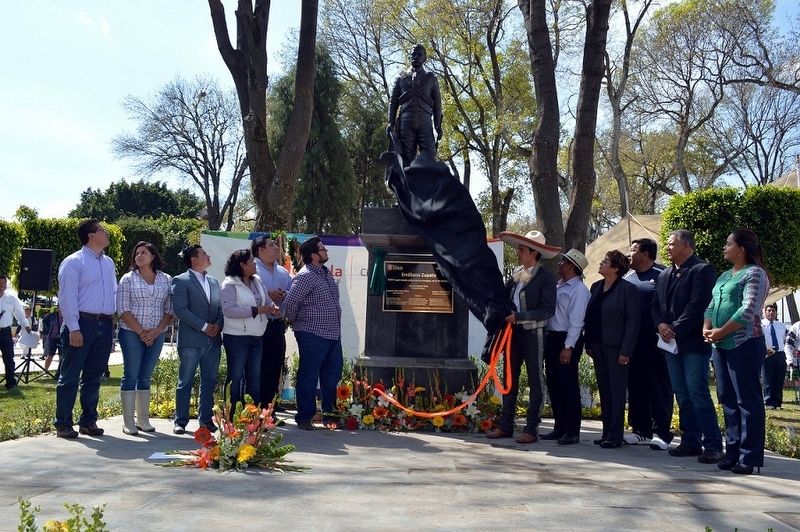San Pedro Cholula, Puebla, Mexico — The Central Highlands (North America)
Emiliano Zapata
"Quiero morir siendo esclavo de los principios, no de los hombres"
José Juan Espinosa Torres
Presidente Municipal
Esperanza Estela Chilaca Muñoz
Síndico Municipal
Ignacio A. Molina Huerta
Secretario de Ayuntamiento
Regidores
Eduardo Blanca Dieste · Marcelino Calzadilla García · Ricardo García Coconi · Santiago Cárcoba Ricco · María Guadalupe Tecotl Flores · Eduardo Aguilar Ramos · Víctor Manuel Romero Tecpanecatl · Saltiel Arturo Carranco Blanca · Pablo Ricardo Melgarejo Luna · María de la Luz Miramon Reyes · Carmen María Rojas Franco · Renato Augusto Lorenzini Rangel
San Pedro Cholula Puebla, a 20 de noviembre de 2014.
"I want to die as a slave to principles, not to men"
Names of municipal authorities
San Pedro Cholula Puebla, November 20, 2014.
Erected 2014 by Gobierno Municipal de San Pedro Cholula.
Topics. This historical marker is listed in these topic lists: Patriots & Patriotism • Wars, Non-US. A significant historical date for this entry is November 20, 2014.
Location. 19° 3.775′ N, 98° 18.331′ W. Marker is in San Pedro Cholula, Puebla. Marker is on Avenida 4 Oriente, on the right when traveling east. The statue and marker are on the northeastern corner of La Concordia Park. Touch for map. Marker is in this post office area: San Pedro Cholula PUE 72760, Mexico. Touch for directions.
Other nearby markers. At least 8 other markers are within walking distance of this marker. Parish of San Pedro Apostle (about 90 meters away, measured in a direct line); Franciscan Convent of The Archangel Gabriel / San Pedro Cholula (about 120 meters away); Bernardino Rivadavia (about 120 meters away); Dr. Alfredo Toxqui Fernández de Lara (about 150 meters away); Dr. Moisés Toxqui Avila (approx. 0.3 kilometers away); Cholula (approx. 0.6 kilometers away); Sanctuary of The Remedies (approx. 0.6 kilometers away); The Wishing Well of Cholula (approx. 0.8 kilometers away). Touch for a list and map of all markers in San Pedro Cholula.
Regarding Emiliano Zapata. Emiliano Zapata Salazar (b. 8 August 1879 – d. 10 April 1919) was a leading figure in the Mexican Revolution, the main leader of the peasant revolution in the state of Morelos, and the inspiration of the agrarian movement called Zapatismo.
Zapata was born in the rural village of Anenecuilco, Morelos, where peasant communities were under increasing pressure from the small landowning class who monopolized land and water resources for sugar cane production with the support of dictator Porfirio Díaz. Zapata early on participated in political movements against Diaz and the large landowners, and when the Revolution broke out in 1910 he was positioned as a central leader of the peasant revolt in Morelos. Cooperating with a number of other peasant leaders he formed the Liberation Army of the South of which he soon became the undisputed leader. Zapata's forces contributed to the fall of Díaz, defeating the Federal Army in the Battle of Cuautla. However, when Francisco I. Madero became president he disavowed the role of the Zapatistas, denouncing them as simple bandits. In November 1911, Zapata promulgated the Plan de Ayala which called for substantial land reforms, redistributing lands to the peasants. Madero sent the Federal Army to root out the Zapatistas in Morelos. Madero's generals employed a scorched earth policy, burning villages and forcibly removing their inhabitants, drafting many men into the Army or sending them to forced labor camps in Southern Mexico. This strengthened Zapata's standing among the peasants and Zapata was able to drive the forces of Madero, led by Victoriano Huerta, out of Morelos. In a coup against Madero in February 1913, Huerta took power in Mexico, but a coalition of Constitutionalist forces in Northern Mexico led by Venustiano Carranza, Álvaro Obregón and Francisco Villa then ousted him in July 1914 with the support of Zapata's troops. Zapata did not recognize the authority that Carranza asserted as leader of the revolutionary movement, continuing his adherence to the Plan de Ayala.
In the aftermath of the revolutionaries' victory over Huerta, they attempted to sort out power relations in the Convention of Aguascalientes. Zapata and Villa broke with Carranza, and Mexico descended into all-out civil war among the winners. Zapata focused his energies on rebuilding Morelos, which he now controlled, instituting the land reforms of the Plan de Ayala. As Carranza consolidated his power and defeated Villa in 1915, Zapata initiated guerrilla warfare against the Carrancistas, who in turn invaded Morelos, employing once again scorched earth tactics to oust the Zapatista rebels. Zapata once again retook Morelos in 1917 and held most of the state against Carranza's troops until he was killed in an ambush in April 1919.
After his death Zapatista generals aligned with Obregón against Carranza and helped drive Carranza from power. In 1920, Zapatistas managed to obtain powerful posts in the governance of Morelos after Carranza's fall. They instituted many of the land reforms envisioned by Zapata in Morelos.
Zapata remains an iconic figure in Mexico, used both as a nationalist symbol as well as a symbol of the neo-Zapatista movement. Adapted from Wikipedia
Credits. This page was last revised on June 7, 2017. It was originally submitted on June 7, 2017, by J. Makali Bruton of Accra, Ghana. This page has been viewed 477 times since then and 18 times this year. Photos: 1, 2, 3, 4, 5. submitted on June 7, 2017, by J. Makali Bruton of Accra, Ghana.
